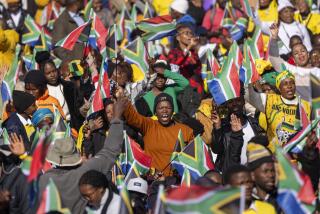TRYING TO DISMANTLE APARTHEID
- Share via
Nelson Mandela, who brought his message of hope and endurance to the United States this week, is the best-known opponent of apartheid, South Africa’s decades-old system of racial segregation.
In his appearances across the nation, Mandela has focused largely on the need to dismantle apartheid, which dates informally back to the practices of the early white settlers.
Laws that codified and expanded those informal policies included: the Prohibition of Mixed Marriages Act (1949); the Population Registration Act (1950), a racial register of the entire population; the Immorality Act (1950), banning sexual intercourse between races; the Group Areas Act (1950), which restricted ownership of land and property and determined where individuals could live and work; the Pass Laws (1952), which required that blacks carry identification papers at all times or face fines and imprisonment; and the Separate Amenities Act (1953), which gave governments and privately owned businesses the right to reserve facilities for whites such as parks, hotels, swimming pools and toilets.
Slowly, some of those laws have begun to crumble. Some of the recent changes in the apartheid laws include:
1985
April 15--Laws prohibiting interracial marriage and sexual relations are repealed.
1986
July 1--President Pieter W. Botha repeals the much-hated Pass Laws. Other reforms include: lifting of restrictions on the movement of blacks to urban areas; elimination of legal racial barriers to hotels and restaurants; change in the status of more than 2 million blacks from citizens of tribal homelands to South African citizens; changes in laws that gave blacks the right to own property, not just lease it, in black townships and downtown business districts; an increase in the authority of black municipal governments; and appointment of blacks as well as Indians and Coloreds (persons of mixed race) to the country’s first multiracial provincial governments.
1989
Sept. 6--President F. W. de Klerk launches a series of reforms, allowing peaceful demonstrations and the integration of beaches.
1990
Feb. 2--De Klerk legalizes the African National Congress, the country’s leading opposition group, and more than 60 other opposition groups, suspends the death penalty, and eases emergency restrictions.
Feb. 11--Nelson Mandela is released after serving 27 years in prison.
May 16--The De Klerk Administration announces that it intends to open vacant wings of white hospitals to blacks.
June 19--Parliament repeals the Separate Amenities Act, leading to integration of public facilities.
PORTIONS OF APARTHEID STILL IN EFFECT
* The Population Registration Act, which serves as the underpinning of the apartheid system. Reversal of this act would require a new constitution.
* Laws that deny the vote in national affairs to the country’s 27 million blacks. De Klerk still opposes a one-person, one-vote, majority-rule system.
* The Group Areas Act. De Klerk opposes full repeal of the measure and appears to favor a system that would allow some neighborhoods to remain segregated. These laws help maintain segregation in public schools.
* The Land Act, which prohibits blacks from owning property in most areas of the country.
More to Read
Sign up for Essential California
The most important California stories and recommendations in your inbox every morning.
You may occasionally receive promotional content from the Los Angeles Times.













